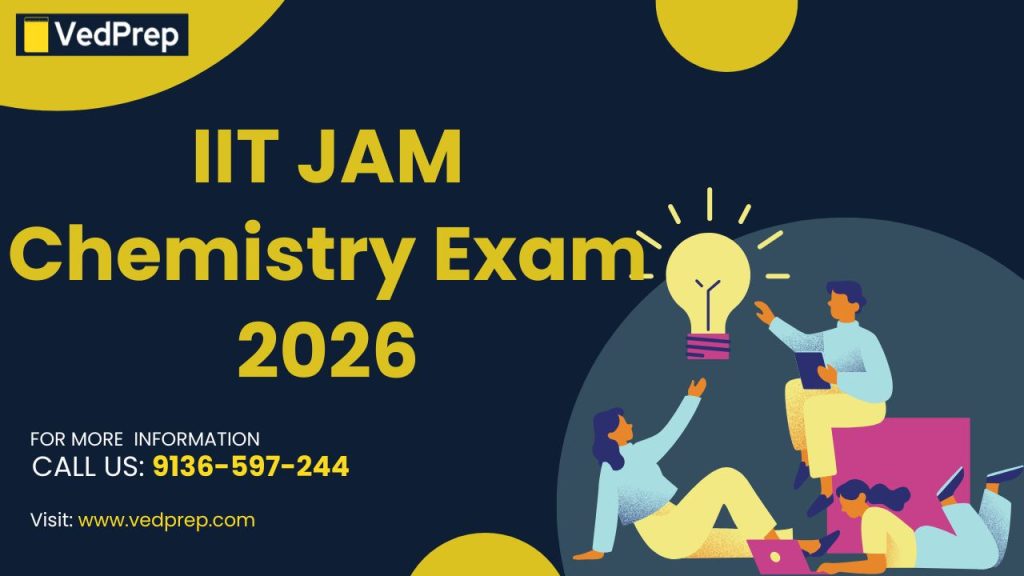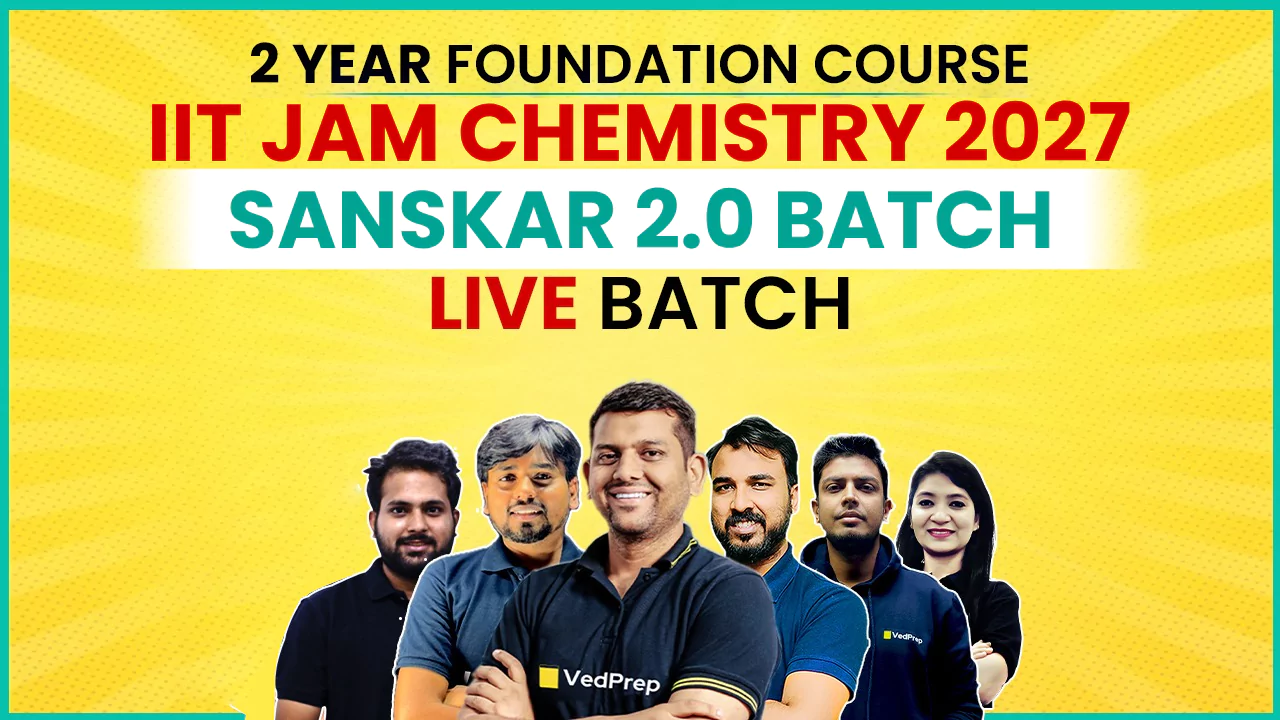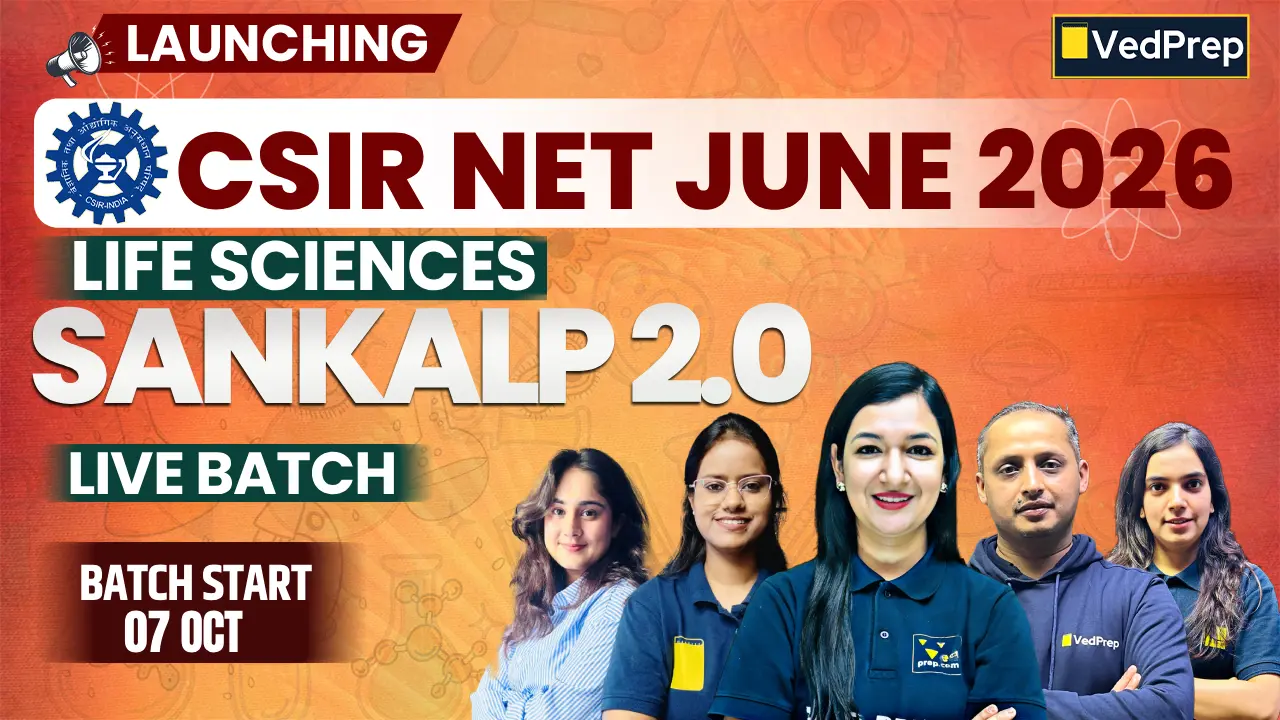IIT JAM Chemistry Exam 2026 notification was released by the officials of IIT Bombay on 26 July 2025 for admission to Master’s degree and Integrated PhD programs at IITs, NITs, and other participating institutes. IIT JAM Application Form 2026 started from 5 September 2025, and the last date of form submission is 12 October 2025. For detailed information on IIT JAM Chemistry 2026 registration dates, eligibility criteria, exam pattern, syllabus, cut-offs, and the complete admission process, read this article.
What is IIT JAM?
IIT JAM conducts the exam every year in February. The exam date is confirmed on 15 February 2026, along with official notification released for IIT JAM Exam 2026 by conducting authority, IIT Bombay.
IIT JAM (Joint Admission Test for M.Sc.) is a national-level exam conducted for admission to the M.Sc. and integrated PhD degree programs offered by IITs, NITs, and other institutes that share IIT JAM scores/results. IIT JAM provides admission in 7 courses: Physics, Chemistry, Mathematics, Economics, Mathematical Statistics, Geology, and Biotechnology.
IIT JAM exam tests the subjective knowledge and skills in the respective areas. It examines the candidate’s analytical ability, quantitative aptitude, and subject-specific understanding. So, for scoring a higher rank in IIT JAM, one has to prepare properly and understand the topics clearly.
Also read IIT JAM Notification 2026
IIT JAM Chemistry Exam 2026 Overview
IIT JAM 2026 Exam notification has been released by the officials of IIT Bombay. IIT JAM Exam 2026 covers a wide range of subjects, and is conducted at the national level. The overview of IIT JAM Chemistry Exam 2026 is listed below-
| Particulars | Details |
| Exam name | IIT JAM Chemistry 2026 |
| Conducting body | IIT Bombay |
| Exam level | National |
| Mode of exam | Computer Based Test(CBT) |
| Course offered through an entrance exam | M.Sc. & integrated PhD. |
| Exam fee | INR 1000 (for females of any category )
INR 1350(for a female applying for two subjects) INR 2000(all other categories applying for one subject ) INR 2700 (for other candidates applying for two subjects) |
| Total marks | 100 |
| Total no. of questions | 60 |
| Marking scheme | Section A 1 marks
Section B 2marks Section C 2 marks |
| Medium | English |
| Colleges accepting IIT JAM Scores | IITs, NITs, CFTIs & IISC Bangalore |
| Total no. of seats | 2900(approx.) |
| No. of exam cities | 113 |
| Application mode | online |
| Exam duration | 3 hours |
| Exam frequency | Once a year |
IIT JAM Chemistry Exam 2026 Important Dates
Some important dates regarding IIT JAM Chemistry Exam 2026 registration starting date, admit card releasing date, exam date, and counselling starting dates are given in the table below-
| IIT JAM Chemistry Exam 2026 Important Dates | |
| IIT JAM 2026 Examination Schedule | Date (Expected) |
| IIT JAM 2026 notification out | 26 July 2025 |
| JAM online application processing system(JOAPS) opens | 5 September 2025 |
| Last date of online registration / form submission | 12 October 2025 |
| Availability of the IIT Jam admit card for download | 5 January 2026 |
| Date of jam Exam | 15 February 2026 |
| Declaration of Jam Result 2026 | 20 March 2026 |
| Portals for admissions | Ist week of April 2026 |
IIT JAM Chemistry Exam 2026 Exam Eligibility Criteria
IIT JAM Chemistry Exam 2026 eligibility Criteria released along with the official notification.IIT JAM Chemistry Exam 2026 eligibility criteria is listed below;
| IIT JAM Chemistry 2026 Eligibility Criteria | |
| Eligibility criteria | Details |
| Nationality | Indian and foreign nations both can apply for the IIT JAM exam |
| Educational qualification |
|
| Appearing candidates | Candidates in the final year are eligible to apply for the IIT JAM Exam Form |
IIT JAM Chemistry Exam 2026 Pattern
IIT JAM 2026 Chemistry Exam Pattern helps candidates to understand the paper pattern, sectional marks distribution and weightage of each section. This allows candidates to make a solving strategy during the Exam.
IIT JAM 2026 chemistry Exam Pattern is listed below
| IIT JAM Chemistry Exam Pattern 2026 | |||
| Sections | Type of questions | No. of questions | Marks |
| Section A | MCQs+ | 30 | 10*1+20*2=50 |
| Section B | MSQs | 10 | 10*2=20 |
| Section C | NAT | 20 | 10*1+10*2=30 |
| Total | 60 | 100 | |
Also read IIT JAM Eligibility Criteria
IIT JAM Chemistry Exam 2026 Syllabus
IIT JAM Chemistry exam 2026 syllabus is mainly divided into three major parts: Physical chemistry, Organic chemistry, and Inorganic chemistry. The paper code for Chemistry is CY. The detailed syllabus for each part is listed below-
Basic Mathematical Concepts (10+2 Level) Functions; maxima and minima; integrals; ordinary differential equations; vectors and matrices; determinants; elementary statistics
| Topic | Key Areas Covered |
| Functions | Types of functions (polynomial, trigonometric, exponential, logarithmic); domain, range; composition; inverse functions |
| Maxima and Minima | Finding turning points; first & second derivative tests; optimization problems |
| Integrals | Indefinite and definite integrals; area under curve; integration by substitution, parts, partial fractions |
| Ordinary Differential Equations (ODEs) | First-order and higher-order ODEs; linear differential equations; applications |
| Vectors and Matrices | Vector algebra; dot and cross product; matrix operations; inverse, rank; eigenvalues & eigenvectors |
| Determinants | Expansion, properties; solving linear equations (Cramer’s Rule); consistency of systems |
| Elementary Statistics | Measures of central tendency (mean, median, mode); dispersion (variance, standard deviation); probability basics |
IIT JAM Physical Chemistry Syllabus 2026
IIT JAM Physical Chemistry syllabus, major topics such as Atomic and Molecular Structure, Gaseous State, Liquid State, Chemical Thermodynamics, Chemical and Phase Equilibria, Electrochemistry, Chemical Kinetics, Adsorption, and Spectroscopy are covered. The detailed subtopics of each topic are given in the table below
| Topic | subtopic |
| Atomic and Molecular Structure | Planck’s black body radiation, Photoelectric effect, Bohr’s theory, de Broglie postulate, Heisenberg’s Uncertainty Principle; Schrödinger’s wave equation (including mathematical treatment), postulates of quantum mechanics, normalized and orthogonal wave functions, its complex conjugate (idea of complex numbers) and significance of Ѱ2; Operators; Particle in one- dimension box, radial and angular wave functions for hydrogen atom, radial probability distribution; Finding maxima of distribution functions (idea of maxima and minima), energy spectrum of hydrogen atom; Shapes of s, p, d and f orbitals; Pauli’s Exclusion Principle; Hund’s rule of maximum multiplicity. |
| Gaseous State | Kinetic molecular model of a gas: collision frequency; collision diameter; mean free path and viscosity of gases; Maxwell-Boltzmann distribution: molecular velocities, law of equipartition of energy, molecular basis of heat capacities; Ideal gases, and deviations from ideal gas behaviour, van der Waals equation of state; critical state, law of corresponding states |
| Liquid State | Physical properties of Liquid, vapour pressure, surface tension, and coefficient of viscosity and their applications; effect of concentration of solutes on surface tension and viscosity; effect of temperature on viscosity of liquids. |
| Solid State | Unit Cells, Miller indices, crystal systems and Bravais Lattices, elementary applications of vectors to crystal systems; X-ray diffraction, Bragg’s Law, Structure of NaCl, CsCl, and KCl, diamond, and graphite; Close packing in metals and metal compounds, semiconductors, insulators; Defects in crystals, lattice energy; isomorphism; heat capacity of solids |
| Chemical Thermodynamics | Mathematical treatment: Exact and inexact differentials, partial derivatives, Euler’s reciprocity, cyclic rule; Reversible and irreversible processes; Laws of thermodynamics, thermochemistry, thermodynamic functions, such as enthalpy, entropy, and Gibbs free energy, their properties and applications; Partial molar quantities, dependence of thermodynamic parameters on composition, Gibbs-Duhem equation, chemical potential and its applications |
| Chemical and Phase Equilibria | Law of mass action; Kp, Kc, Kx and Kn; Effect of temperature on K; Le-Chatelier principle; Ionic equilibria in solutions; pH and buffer solutions; Salt hydrolysis; Solubility and solubility product; Acid – base titration curves; Indicators; Dilute solutions; Raoult’s and Henry’s Laws and their applications; Colligative properties; Gibbs phase rule; Phase equilibria; single and two- component phase diagrams. |
| Electrochemistry | Conductivity, equivalent and molar conductivity and their properties; Kohlrausch law; DebyeHückel-Onsager equation; Ionic velocities, mobilities, transference numbers; Applications of conductance measurement; Quantitative aspects of Faraday’s laws of electrolysis, applications of electrolysis in metallurgy and industry; Electromotive force of a cell, Nernst equation; Standard electrode potential, Electrochemical series; Concentration cells with and without transference; Applications of EMF measurements including potentiometric titrations |
| Chemical Kinetics | Order and molecularity of a reaction, differential and integrated form of rate expressions; Kinetics of opposing, parallel, and consecutive reactions; Steady state approximation in reaction mechanisms; Chain reactions; Uni-molecular reaction (Lindemann mechanism); Temperature dependence of reaction rates, Arrhenius equation; activation energy; Collision theory of reaction rates; Types of catalysts, specificity and selectivity, mechanisms of catalyzed reactions at solid surfaces; Enzyme catalysis (Michaelis-Menten mechanism, Double reciprocal plot), Acid-base catalysis |
| Adsorption | Gibbs adsorption equation; adsorption isotherm; types of adsorption; surface area of adsorbents; surface films on liquids |
| Spectroscopy | Beer-Lambert’s law; fundamental concepts of rotational, vibrational, electronic, and magnetic resonance spectroscopy |
IIT JAM Organic Chemistry Syllabus 2026
IIT JAM Organic Chemistry syllabus, major topics such as Basic Concepts in Organic Chemistry and Stereochemistry, Organic Reaction Mechanism and Synthetic Applications, Qualitative Organic Analysis, and Aromatic and Heterocyclic Chemistry are covered. The detailed subtopics of each topic are given in the table below
| Topic | Subtopic |
| Basic Concepts in Organic Chemistry and Stereochemistry | Electronic effects (resonance, inductive, hyperconjugation) and steric effects and their applications (acid/base property); optical isomerism in compounds with and without any stereocenters (allenes, biphenyls); conformation of acyclic systems (substituted ethane/n-propane/n-butane) and cyclic systems, substituted cyclohexanes, and polycyclic (cis and trans decalins) systems |
| Organic Reaction Mechanism and Synthetic Applications | Chemistry of reactive intermediates (carbocations, carbanions, free radicals, carbenes, nitrenes, benzynes); nucleophilic substitution, elimination reactions and mechanisms; Hofmann-CurtiusLossen rearrangement, Wolff rearrangement, Simmons-Smith reaction, Reimer-Tiemann reaction, Michael reaction, Darzens reaction, Wittig reaction and McMurry reaction; Pinacolpinacolone, Favorskii, benzilic acid rearrangement, Baeyer-Villeger reaction; oxidation and reduction reactions in organic chemistry; Organometallic reagents in organic synthesis (Grignard, organolithium, organocopper and organozinc (Reformatsky only); Diels-Alder, electrocyclic and sigmatropic reactions; functional group inter-conversions and structural problems using chemical reactions |
| Qualitative Organic Analysis | Identification of functional groups by chemical tests; elementary UV, IR, and 1H NMR spectroscopic techniques as tools for structural elucidation of simple organic molecules |
| Natural Products Chemistry | Chemistry of alkaloids, steroids, terpenes, carbohydrates, amino acids, peptides, and nucleic acids. |
| Aromatic and Heterocyclic Chemistry | Monocyclic, bicyclic and tricyclic aromatic hydrocarbons, and monocyclic compounds with one hetero atom: synthesis, reactivity and properties, aromaticity; Electrophilic and nucleophilic aromatic substitution reactions |
IIT JAM Inorganic Chemistry Syllabus
In the IIT JAM Inorganic Chemistry syllabus, major topics such as Periodic Table, Extractions of Metals, Chemical Bonding and shapes of molecules, Main Group Elements (s and p blocks), Transition Metals (d block), Bioinorganic Chemistry, Instrumental Methods of Analysis, Analytical Chemistry are covered. The detailed subtopics of each topic are given in the table below
| Topic | Subtopic |
| Periodic Table | Periodic classification of elements, Aufbau’s principle, periodicity; Variations of orbital energy, effective nuclear charge, atomic, covalent, and ionic radii, ionisation enthalpy, electron gain enthalpy, and electronegativity with atomic number, electronic configuration of diatomic molecules (first and second row elements) |
| Extractions of Metals | General methods of isolation and purification of elements; Principles and applications of the Ellingham diagram. |
| Chemical Bonding and shapes of molecules | Ionic bond: Packing of ions in crystals, radius ratio rule, Born-Landé equation, Kapustinskii expression, Madelung constant, Born-Haber cycle, solvation energy, polarising power and polarizability; Fajan’s rules; Covalent bond: Lewis structure, valence bond theory. Hybridization, molecular orbital theory, molecular orbital diagrams of diatomic and simple polyatomic molecules and ions; Multiple bonding (σ and 𝜋 bond approach) and bond lengths; van der Waals forces, ion-dipole forces, dipole-dipole interactions, induced dipole interactions, instantaneous dipoleinduced dipole interactions, hydrogen bonding; Effect of intermolecular forces on melting and boiling points, solubility energetics of dissolution process; Bond dipole, dipole moment, and molecular polarizabilities; VSEPR theory and shapes of molecules; ionic solids. |
| Main Group Elements (s and p blocks) | Reactions of alkali and alkaline earth metals with oxygen, hydrogen and water; Alkali and alkaline earth metals in liquid ammonia; Gradation in properties of main group element in a group; Inert pair effect; Synthesis, structure and properties of diborane, ammonia, silane, phosphine and hydrogen sulphide; Allotropes of carbon; Oxides of nitrogen, phosphorus and sulphur; Oxoacids of phosphorus, sulphur and chlorine; Halides of silicon and phosphorus; Synthesis and properties of borazine, silicone and phosphazene; Synthesis and reactions of xenon fluorides. |
| Transition Metals (d block) | Characteristics of d-block elements; oxide, hydroxide and salts of first row metals; coordination complexes: structure, isomerism, reaction mechanism and electronic spectra; VB, MO and crystal field theoretical approaches for structure, color and magnetic properties of metal complexes; Organometallic compounds with metal-ligand single and multiple bonds (such as metal carbonyls, metal nitrosyls and metallocenes); Homogenous catalysis involving Wilkinson’s catalyst. |
| Bioinorganic Chemistry | Essentials and trace elements of life; basic reactions in the biological systems and the role of metal ions, especially Fe2+, and Zn2+; structure and function of myoglobin, haemoglobin, and carbonic anhydrase. |
| Instrumental Methods of Analysis | Basic principles, instrumentations, and simple applications of conductometry, potentiometry, and UV-vis spectrophotometry; analyses of water, air, and soil samples |
| Analytical Chemistry | Principles of qualitative and quantitative analysis; Acid-base, oxidation-reduction, and complexometric titrations using EDTA; Precipitation reactions; Use and types of indicators; Use of organic reagents in inorganic analysis; Radioactivity, nuclear reactions, applications of isotopes; Mathematical treatment in error analysis, elementary statistics, and probability theory. |
Also read IIT Jam Syllabus
IIT JAM Chemistry Exam 2026 Cut-Offs
IIT JAM Chemistry cut off will be available after declaration of IIT JAM result 2026 on 20 March 2026. IIT JAM Exam admit card will be released on 5 January 2026 and exam will be conducted on 15 February 2026. We will provide official link here once released by officials of IIT Bombay.
IIT JAM Chemistry Exam 2026 Admission Process
After the announcement of IIT JAM 2026 results, qualified candidate satisfying the eligibility requirements(ERs) and minimum essential qualifications (MEQs) seeking for admissions, have to apply online through IIT JAM 2026 Counselling website to the preferred programmes in IITs where admission is sought. The candidate needs to provide the required information, such as choice of the programmes in order of preference, educational qualifications, percentage of marks/CGPA, category, PwD status, etc. A payment of ₹750 (Rupees Seven hundred and fifty only) is to be made online as a nonrefundable processing fee. Foreign nationals with Indian degree are eligible to apply, subject to the policy of the Admitting Institute.
IIT JAM Chemistry PYQs
IIT JAM cemistry PYQs of last 5 years are provided in the table below
IIT JAM Chemistry PYQs |
|
|---|---|
| IIT JAM Chemistry PYQs (Year) | Download link |
| 2025 | Download here |
| 2024 | Download here |
| 2023 | Download here |
| 2022 | Download here |
| 2021 | Download here |
IIT JAM Chemistry Exam Study Material
IIT JAM Chemistry Exam Stusy Material are provided in table below
| IIT JAM Chemistry Exam Study Materilas | |
|---|---|
| Resource Type | Details |
| Previous Years’ Papers | Solving past papers helps you understand the exam pattern, time management, and common question types. |
| Sample Papers | Sample papers mirror the format and difficulty of the exam. They help assess readiness and improve time management. |
| IIT JAM Chemistry Practice Books | Books designed for detailed theory explanations and practice questions. Focus on conceptual clarity and problem-solving skills. |
| Online Mock Tests | Regular practice of online mock tests helps track progress and simulate the actual exam environment. |
| Coaching Institute Sample Papers | These papers are curated by experts based on the IIT JAM pattern. They can vary in difficulty, providing a broad perspective on potential exam questions. |
Best Books for IIT JAM Chemistry Exam
Best books for IIT JAM Chemistry Exam are provided in the table below
| Best Books for IIT JAM CHEMISTRY Exam | |
|---|---|
| Subject | Book Title |
| Physical Chemistry |
|
| Inorganic Chemistry |
|
| Organic Chemistry |
|
Ace your IIT JAM preparation, join Ved Prep online programs. Ved Prep Provides courses, study materials, test series and more
IIT JAM Chemistry Exam 2026 FAQs
Is there any age limit to apply for the IIT JAM Chemistry Exam 2026?
No, there is no age limit to apply for the IIT JAM Exam. Candidates of any age can apply for the IIT JAM Exam.
Can we apply for two papers in the IIT JAM Exam?
Yes, one candidate can apply for two papers in the IIT JAM Exam, but additional charges are applied and will be mentioned in the fees section of the official notification.
How can we get the detailed syllabus for the IIT JAM Chemistry Exam?
For a detailed syllabus for the IIT JAM Chemistry Exam Syllabus 2026, one can visit the official site of IIT JAM. On the site in the examination section, you can download a detailed syllabus.
How can we download PYQs for the IIT JAM Chemistry Exam?
You can visit the official site for PYQs of the IIT JAM EXAM easily. On the site in the exam section, you can download PYQs.
Is solving PYQs beneficial for scoring high marks in the IIT JAM Chemistry Exam?
Solving PYQs during the preparation of the exam is a milestone for the IIT JAM Exam. In some cases same questions are repeated in the exam.




